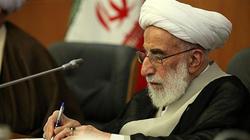 Ayatollah Ahmad Jannati, the secretary of Iran’s Guardian Council (GC), which vets candidates for elections, has highlighted the importance of the upcoming parliamentary elections in the country, calling on observers of the votes to help executive committees hold “healthy and lawful elections” under close scrutiny and without interference in the voting process.
Ayatollah Ahmad Jannati, the secretary of Iran’s Guardian Council (GC), which vets candidates for elections, has highlighted the importance of the upcoming parliamentary elections in the country, calling on observers of the votes to help executive committees hold “healthy and lawful elections” under close scrutiny and without interference in the voting process. RNA - In a Tuesday message addressed to the monitors of the elections due on Friday, Ayatollah Jannati said all observers, regardless of their political or factional inclinations, had to apply the rule of law and avoid bias.
As stated in law, he said, the country’s armed forces, the three branches of government, and intelligence and security apparatus are not allowed to interfere in the voting procedure.
“Any misuse of public resources and government facilities in favor of a current or future candidate is contrary to electoral justice,” he said.
He said that all observers were obliged to make sure that the candidates are financially healthy and therefore less prone to fraud.
“All observers of the Guardian Council are obliged, with particular sensitivity to this matter, to confirm and announce the financial health of the candidates for the parliament and consider any documented and credible report regarding” any possible corruption cases.
“Do not neglect the rights of the people and the rights of the candidates,” Jannati told the observers, adding all candidate complaints should be reviewed and documented.
“Judgments in this regard are based solely on the rule of law and justice and there is a need to respond to their objections and questions,” he said.
Iran’s 11th parliamentary elections will be held on February 21, 2020. The date will also feature interim elections for Iran’s Assembly of Experts, which elects and oversees the activities of the Leader of the Islamic Revolution.
Campaigns officially started on Thursday and the candidates have one week to win the people’s support for their candidacy. After campaigning is over, there will be a 24-hour silence period until voting begins on Friday morning.
More than 7,000 candidates are competing to enter the parliament. A winning candidate must have at least 20 percent of the votes cast in their constituency in order to become lawmaker for a four-year term.
A total of 57,918,000 people are eligible to cast their ballots. There would be one lawmaker at Majlis per each 190,000-strong segment of the Iranian population.
847/940